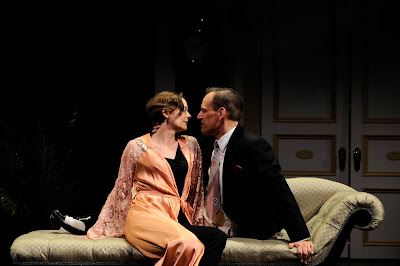This week is your last chance to see Sarah Ruhl’s Stage Kiss—a play which features every kind of kiss imaginable—before it closes on June 5. In a recent issue of OnStage, as well as on this very blog, Associate Producer Steve Scott broke down some of the silver screen’s most iconic kisses. From the first kiss ever filmed in 1896, to more recent kisses such as that between two lovers in 2005’s Brokeback Mountain, cinema kisses have caught our attention for years. Cinema kisses, though, are not the only artistic renderings of kissing that have entranced the masses! Before there was access to film, artists were sculpting, drawing, etching and painting kisses for ages! To honor these embraces, frozen in time and form, we bring you five iconic kisses in art history!
 Henri de Toulouse-Lautrec—The Kiss (1892)
Henri de Toulouse-Lautrec—The Kiss (1892)Lautrec found himself consumed with the topic of brothel women for some time, and The Kiss is one of many canvases from this era. This particular embrace, painted in bold red colors and capturing a passionate female couple, shows the beginning of his curiosity with lesbianism. Later canvases reflected similar couples in bed, sometimes kissing, other times separate. Whether he was a champion of their lifestyle or a critic is debated by art historians, but there is no denying the moments he captured between these women in day, when the customers and spectators were away, show us a much different side of their life.
Auguste Rodin—The Kiss (1889)

Originally conceived as a single image among many in his The Gates of Hell relief, The Kiss is a reference to a story in Dante’s Inferno. Circle 2, Canto 5, describes the story of a thirteenth-century Italian woman who falls for her husband’s brother. Much like He and She in Stage Kiss, whose flames are ignited by the story they share on stage, this portion of Inferno describes Francesca and Paolo falling in love while reading the story of Lancelot and Guinevere. In the sculpture you can see Paolo clutching a copy of the book that spurred their love.
Gustav Klimt—The Kiss (1907)
 The Kiss is one of, if not the most famous work by Gustav Klimt. Both the man and woman actively hold each other, indicating a rather intimate embrace. Klimt created this work just 10 years after helping found the Vienna Secession, a movement in Austrian art away from historical relevance and toward artistic freedom.
The Kiss is one of, if not the most famous work by Gustav Klimt. Both the man and woman actively hold each other, indicating a rather intimate embrace. Klimt created this work just 10 years after helping found the Vienna Secession, a movement in Austrian art away from historical relevance and toward artistic freedom. Marc Chagall—Birthday (1915)
 No artist so loved his wife as Chagall did Bella. Her likeness appears in a number of his works, and Birthday depicts another day in their journey as lovers. After four years of working, studying art and missing Bella while in Paris, Chagall returned home to Russia. This painting, created soon after his return, depicts a birthday of Bella’s that the two were able to spend together. Many viewers note how the contorted body of the male appears to be “bending over backwards,” to kiss her, and liken it to a representation of Chagall doing anything for Bella, especially on her birthday.
No artist so loved his wife as Chagall did Bella. Her likeness appears in a number of his works, and Birthday depicts another day in their journey as lovers. After four years of working, studying art and missing Bella while in Paris, Chagall returned home to Russia. This painting, created soon after his return, depicts a birthday of Bella’s that the two were able to spend together. Many viewers note how the contorted body of the male appears to be “bending over backwards,” to kiss her, and liken it to a representation of Chagall doing anything for Bella, especially on her birthday.  Pablo Picasso—The Kiss (1969)
Pablo Picasso—The Kiss (1969) While Picasso painted many kisses in his career, The Kiss of 1969 stands out because its production year. In 1967 and 1968 Picasso completed his extremely joyful, funny and explorative “367 series,” consisting of 367 prints (etchings, dry points, and aquatints) completed in one year at the age of 87! Both the series and this oil painting display Picasso’s never ending joie de vivre; for it was at the age of 88 that Picasso painted this bold and emotional kiss. The painting later went on to sell at auction for $17.4 million dollars (in 2008), an amazing feat for a post-1960 Picasso work.















